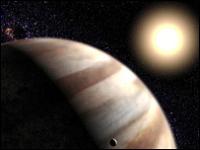







|
News and Information
Lens method finds far-off world
| May 24, 2005 |

By Dr David Whitehouse
Science editor, BBC News website
Artist's concept of a distant world (BBC)
The planet is so distant we could not dream of visiting it
An international team of astronomers has found a planet which, at about 15,000 light-years from Earth, is one of the most distant yet detected.
The new world was discovered when its parent star's gravity distorted the light from an even more distant star.
The way the distant star's light changed betrayed the planet's presence.
Two amateur astronomers in New Zealand helped find the world using "backyard" telescopes, showing that almost anyone can become a planet hunter.
The newly discovered world is several times the mass of Jupiter, but astronomers say the microlensing technique used to find the planet worked so well that it could be used to find much smaller, Earth-sized planets.
Pattern in the signal
Microlensing occurs when a massive object in space, like a star, crosses in front of another star shining in the background.
The near object's gravity bends the light rays from the more distant object and magnifies them like a lens. Here on Earth, we see the star get brighter as the lens crosses in front, and then fade as the lens moves away.
On 17 March 2005, Andrzej Udalski, professor of astronomy at Warsaw University, Poland, and leader of the Optical Gravitational Lensing Experiment (Ogle), noticed that just such an event was about to occur near the centre of our galaxy.
A month later, when the more distant star had brightened a hundred-fold, astronomers from Ogle and from the Microlensing Follow Up Network (MicroFun) detected a new pattern in the signal - a rapid distortion of the brightening - which could only be explained by an additional object close to the foreground star - a planet.
"There's absolutely no doubt that the star in front has a planet, which caused the deviation we saw," said Andrew Gould, of the University of Ohio, US.
Gould's estimate of a 15,000-light-year distance to the new planet is an approximation, and he says he will need more data to refine the number. A light-year is the distance light travels in a year - about 9.5 trillion km (six trillion miles).
Global network
Because the scientists were able to monitor the light signal with high precision, Gould thinks the technique could easily have revealed an even smaller planet.
"If an Earth-mass planet was in the same position, we would have been able to detect it," he said.
Ogle finds more than 600 microlensing events each year using a dedicated 1.3m telescope at Las Campanas Observatory in Chile. MicroFun is a collaboration of astronomers from the US, Korea, New Zealand, and Israel that picks out those events that are most likely to reveal planets and monitors them from telescopes around the world.
"That allows us to watch these events 24/7," Gould said. "When the Sun rises at one location, we continue to monitor from the next."
Two of these telescopes belong to two avid New Zealand amateur astronomers who were recruited by the MicroFun team. Grant Christie of Auckland used a 14-inch (35cm) telescope, and Jennie McCormick of Pakuranga used a 10-inch (25cm) telescope.
Both share co-authorship on the paper submitted to Astrophysical Journal Letters. |
Source: www.bbc.com |
| http://news.bbc.co.uk/2/hi/science/nature/4574233.stm |
|
| Support Caprivi Freedom |
Fill out the form below to become a member of this site and receive our regular newsletter.
|

|

